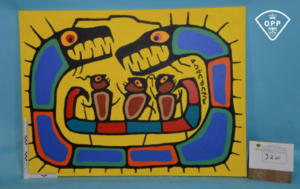A Canadian court has sentenced the main perpetrator of one of the largest art fraud conspiracies. Back in March, I wrote about how police in Ontario had arrested a group of people for creating and selling thousands of artworks being passed off as originals by the Canadian indigenous artist Norval Morrisseau. Morrisseau is recognized today as one of Canada’s greatest artists, putting indigenous art on the map. Even before he died in 2007, he was concerned about forgeries of his work on the market. This led him to create the Norval Morrisseau Heritage Society (NMHS) to manage his estate and provide authentication services.
Beginning between 1996 and 2002, Gary Lamont served as the leader of a forgery ring operating out of Thunder Bay, Ontario. Lamont ran a sort of forgery assembly line, hiring indigenous artists to create new works in Morrisseau’s style, often paying them with alcohol and drugs. One of the ring’s members was Benjamin Paul Morrisseau, the artist’s nephew. Lamont himself would often apply Morrisseau’s signature using the Cree syllabics the artist typically used to sign his name. Lamot’s forgery ring sold each work through intermediaries for anywhere between $2,000 and $10,000. Many of these forgeries have reached Canadian galleries and private collections worldwide. Some have insinuated that the Smithsonian collection contains Morrisseau forgeries and that there are probably many more forgeries on the market than originals. It has been estimated that Lamont’s crew caused the market for Morrisseau works to reduce in value by $100 million. Several people, who bought the fake works, submitted statements to the court, attesting that some of Lamont’s victims were not wealthy collectors but regular people, thinking it would have been a good investment for themselves and their children. The judge overseeing the case, Justice Bonnie Warkentin, said that the actions of Lamot and his conspirators constitute more than just fraud. “It is the appropriation of a cultural and spiritual identity of one of Canada’s most profound artists.”
In early December, Lamont pled guilty to forgery, making false statements, and defrauding the public. He also took full responsibility and expressed remorse. Art lawyer Jonathan Sommer has called Lamont’s guilty plea “a huge step forward” as a guilty plea would save everyone both time and resources. The investigation into Lamont’s activities took over two years, and over a thousand forgeries were confiscated in the process. 190 works were submitted as evidence in the court proceedings as confirmed Lamont forgeries. However, the NMHS’s current director, Cory Dingle, has claimed that there are likely thousands more still circulating out in the marketplace. Because the artist’s estate will be completely overwhelmed in sorting out the forgeries from the authentic works, Dingle has called for the creation of a national art fraud investigation service in Canada. The government is not seeking any restitution in this case. Rather, they recommend that any of the conspiracy’s victims seek damages through a civil suit.

